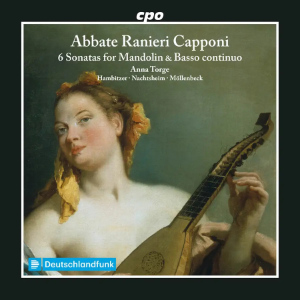
Abbate Ranieri Capponi (1680-1744)
6 Sonatas for Mandolin and Basso Continuo
Anna Torge (mandolin)
Gerald Hambitzer (organ & harpsichord), Andreas Nachtsheim (lute), Markus Möllenbeck (cello)
rec. 2019/22, Deutschlandfunk Kammermusiksaal, Cologne, Germany
cpo 555 039-2 [64]
The six pieces played here constitute the first half of a collection of a dozen sonatas by Capponi, published by his brother at Florence just after the composer’s death in 1744 as Sonate da camera. They are written for an unspecified melodic instrument – no doubt intended for any instrument that could execute the music reasonably well, as was the usual pragmatic approach to small scale music-making in the 18th century. As the music would be undemanding for the violin but suits the mandolin, the Sonatas are all taken by Anna Torge on the latter instrument.
The music is generally contrapuntal rather than adopting the emerging galant style of the time – Sonatas II, III and VI feature fugues. But well-crafted melody remains paramount, and the ensemble plays the music elegantly, with balanced textures, and even a touch of playfulness in those fugues. The clear-toned mandolin is to the fore, with discreet but not subservient accompaniment which suits the music, whether that be contrapuntal, or the more straightforward, melodically driven style of other movements, such as either the busier, concertante character of No. III’s opening movement, which could be mistaken for one of Vivaldi’s chamber concertos without orchestral accompaniment, or the wistful simplicity of No. IV’s Largo which could also be a slow movement by that contemporary of Capponi’s.
Anna Torge plays her baroque mandolin with an attractive directness, without any twanging of longer held notes or any mannered manipulation of the strings, but supplies tasteful ornamentation to phrases, usually in repeated sections. Only in the Allegro finale of No. 1 might one take issue with her overemphasis of the dissonant suspensions that arise in the harmony by repeating the mandolin’s notes at double the speed they are notated, and which also therefore undermines the syncopations that should ensue by eradicating the different rhythmic values of the mandolin’s notes as against those of the continuo. Contrariwise, as both halves of No. III’s opening Allegro are repeated, it’s a pity that Torge doesn’t make more of the intermediate cadences in each by adding a little improvisatory flourish, even if only on the repeats, as the silent pauses after abrupt chords awkwardly dispel momentum. The two minor key Sonatas are played with a slight stringency which expressively underlines their sterner harmony and sometimes pungent chromaticisms.
The instrumental combinations for the continuo vary from one Sonata to the next, providing different timbral backgrounds, and affording subtly different approaches to interpretation. Torge adopts a softer hue in No. V, accompanied by lute and harpsichord, which mitigates against too much of a plucking clangour among three instruments. In No. III’s minor key Larghetto with cello added to that combination, Markus Möllenbeck takes the opportunity to indulge in his contrastingly bowed string tone with yearning, urgent lines.
These are stylish performances of some charming music that are a valuable addition to the mandolin repertoire. Let’s hope the ensemble will follow up with a recording of the remaining six Sonatas.
Curtis Rogers
Buying this recording via a link below generates revenue for MWI, which helps the site remain free



Contents
Sonata I in D major
Sonata II in D minor
Sonata III in C major
Sonata IV in C minor
Sonata V in A major
Sonata VI

















